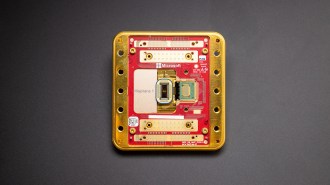Schrödinger’s cat now dead and alive in two boxes at once
Feline-mimicking microwaves offer benefits for quantum computing

CAT CLUES Schrödinger’s mythical cat is alive and dead at the same time. Scientists have wrangled microwaves into similarly bizarre quantum states, and now they are taking the experiment a step further, splitting one catlike state into two boxes.
Mopic/Shutterstock
- More than 2 years ago
Schrödinger’s cat can’t seem to catch a break. The unfortunate imaginary feline is famous for being alive and dead at the same time, as long as it remains hidden inside a box. Scientists have now gone one step further, splitting one living-dead cat between two boxes.
Animal lovers can relax — there are no actual cats involved. Instead, physicists used microwaves to mimic the cat’s weird quantum behavior. The new advance, reported May 26 in Science, brings scientists a step closer to building quantum computers out of such systems.
Schrödinger’s cat is the hapless participant in a hypothetical experiment dreamt up by physicist Erwin Schrödinger in 1935. He imagined a cat in a closed box with a lethal poison that will be released if a sample of radioactive material decays. After any given amount of time passes, quantum math can provide only the odds that the material has decayed and released the poison. So from the quantum perspective, the cat is in a state of superposition — both dead and alive. It remains in limbo until the box is opened, and out comes a purring kitty or a lifeless corpse (SN: 11/20/10, p. 15).
In a real laboratory version of the experiment, microwaves inside a superconducting aluminum cavity take the place of the cat. Inside the specially designed cavity, the microwaves’ electric fields can be pointing in two opposing directions at the same time — just as Schrödinger’s cat can be simultaneously alive and dead. These states are known as “cat states.” Now, physicists have created such cat states in two linked cavities, thereby splitting the cat into two “boxes” at once.
Though the idea of one cat in two boxes is “kind of whimsical,” says Chen Wang of Yale University, a coauthor of the paper, it’s not that far off from the real-world situation. The cat state “is shared in two boxes because it’s a global quantum state.” In other words, the cat is not only in one box or the other, but stretches out to occupy both.
Because the states of the two boxes are linked — or in quantum parlance, entangled — if the cat turns out to be alive in one box, it’s also alive in the other (SN: 11/20/10, p. 22). Wang compares it to a cat with two symptoms of life: an open eye in the first box and a heartbeat in the second box. Measurements from the two boxes will always agree on the cat’s status. For microwaves, this means the electric field will always be in sync in both cavities. The scientists measured the cat states produced and found a fidelity of 81 percent — a measure of how close the state was to the ideal cat state. This fidelity is comparable to that achieved in similarly complex systems, the researchers say.
The result is a step toward quantum computing with such devices. The two cavities could serve the purpose of two quantum bits, or qubits. One stumbling block for quantum computers is that errors inevitably slip in to calculations due to interactions with the outside environment that muck up the qubits’ quantum properties. The cat states are more resistant to errors than other types of qubits, the researchers say, so the system could eventually lead to more fault-tolerant quantum computers.
“I think they’ve made some really great advances,” says Gerhard Kirchmair of the Institute for Quantum Optics and Quantum Information of the Austrian Academy of Sciences in Innsbruck. “They’ve come up with a very nice architecture to realize quantum computation.”
The demonstration of entanglement in the two-cavity system is very important, says Sergey Polyakov of the National Institute of Standards and Technology in Gaithersburg, Md. “The next step would be to demonstrate that this approach is actually scalable” by adding more cavities to the mix to build a bigger quantum computer.







